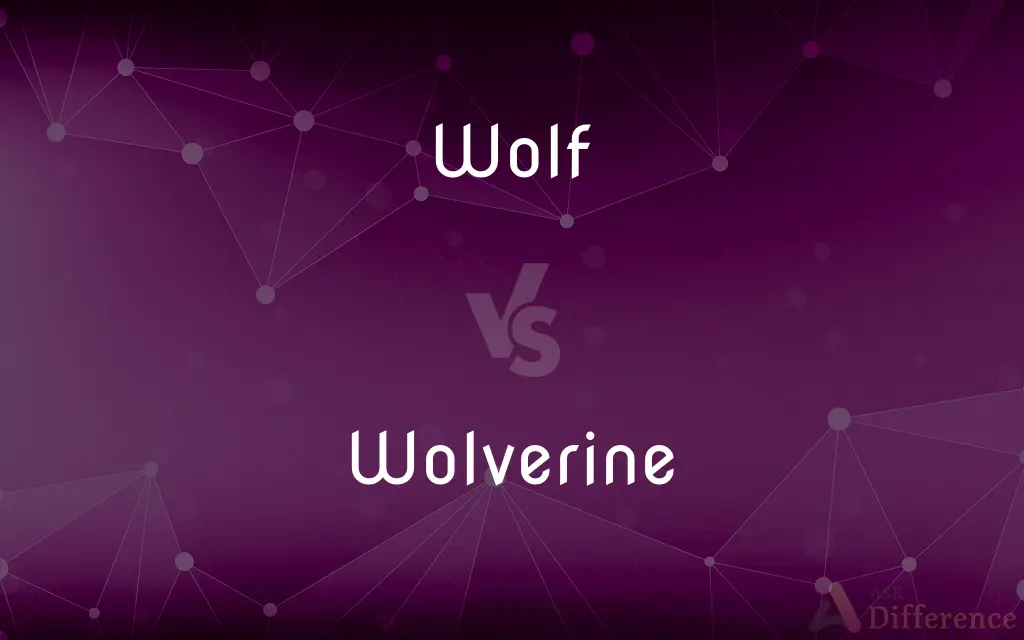Wolf vs. Wolverine — What's the Difference?
By Fiza Rafique & Maham Liaqat — Updated on April 15, 2024
Wolves are social animals living in packs, primarily hunters of large animals, while wolverines are solitary and scavenge more than they hunt.

Difference Between Wolf and Wolverine
Table of Contents
ADVERTISEMENT
Key Differences
Wolves are known for their pack behavior, forming social groups to hunt and survive, while wolverines are typically solitary creatures, rarely forming long-lasting associations with others.
In terms of habitat, wolves thrive in a variety of environments, from Arctic tundra to forests and grasslands, whereas wolverines are more confined to remote boreal forests and alpine tundra.
Regarding diet, wolves mainly hunt large ungulates like deer and elk, coordinating as a pack, whereas wolverines are opportunistic feeders, eating anything from berries to carrion and small animals.
Wolves play a significant role in their ecosystems as apex predators, helping to control the populations of other animals and maintain balance, on the other hand, wolverines are known for their incredible strength and ability to survive in harsh conditions, often considered the ultimate scavengers.
Reproduction in wolves involves the alpha pair typically breeding once a year with communal care for the offspring, whereas wolverines breed with less frequency and the female raises the young alone in a den.
ADVERTISEMENT
Comparison Chart
Social Structure
Lives in packs
Mostly solitary
Habitat
Diverse: forests, tundra, grasslands
Restricted: boreal forests, alpine tundra
Diet
Large ungulates, pack hunters
Opportunistic, scavenges more than hunts
Role in Ecosystem
Apex predator, controls prey populations
Scavenger, survives in harsh conditions
Reproduction
Alpha pair breeds, communal care
Breeds less frequently, raises young alone
Compare with Definitions
Wolf
A large carnivorous mammal belonging to the genus Canis, known for its pack behavior.
The wolf howled at the moon, signaling its pack.
Wolverine
A stocky and muscular carnivore, known for its strength, part of the weasel family.
The wolverine scavenged through the leftover carcasses.
Wolf
A symbol of wilderness and cunning in various cultures.
In folklore, the wolf often plays the role of a wise trickster.
Wolverine
Associated with tenacity and survival skills in extreme environments.
Like a wolverine, he thrived in tough business climates.
Wolf
A term used metaphorically to describe a predatory or ruthlessly aggressive person.
He was known as a wolf in the corporate world.
Wolverine
A fictional superhero character in the Marvel Comics universe.
Wolverine is popular for his healing power and adamantium-clad skeleton.
Wolf
In finance, a term describing aggressive tactics in takeovers or trading.
He acted like a wolf during the Wall Street merger.
Wolverine
In sports, an athlete or team associated with the University of Michigan.
The Wolverines clinched the championship again.
Wolf
In music, an unpleasant sound caused by unwanted vibrations.
The violinist struggled to eliminate the wolf note in her performance.
Wolverine
A term in folklore symbolizing solitary and fierce individuals.
In stories, he was often compared to a wolverine due to his solitary nature.
Wolf
The wolf (Canis lupus), also known as the gray wolf or grey wolf, is a large canine native to Eurasia and North America. More than thirty subspecies of Canis lupus have been recognized, and gray wolves, as colloquially understood, comprise non-domestic/feral subspecies.
Wolverine
The wolverine () (also spelled wolverene), Gulo gulo (Gulo is Latin for "glutton"), also referred to as the glutton, carcajou, or quickhatch (from East Cree, kwiihkwahaacheew), is the largest land-dwelling species of the family Mustelidae. It is a muscular carnivore and a solitary animal.
Wolf
Any of several carnivorous mammals of the genus Canis, especially the gray wolf of northern regions, that typically live and hunt in packs.
Wolverine
A solitary mustelid mammal (Gulo gulo) of northern regions, having a heavyset body, short legs, dark fur, and a bushy tail, and known for its aggressive predatory behavior. Also called carcajou, glutton, skunk bear.
Wolf
The fur of such an animal.
Wolverine
A solitary, fierce mammal of the Mustelidae family, species.
Wolf
Any of various similar or related mammals, such as the hyena.
Wolverine
A resident of Michigan
Wolf
The destructive larva of any of various moths, beetles, or flies.
Wolverine
Wolverine of northern Eurasia
Wolf
One that is regarded as predatory, rapacious, and fierce.
Wolverine
Stocky shaggy-coated North American carnivorous mammal
Wolf
A harshness in some tones of a bowed stringed instrument produced by defective vibration.
Wolf
Dissonance in perfect fifths on a keyboard instrument tuned to a system of unequal temperament.
Wolf
To eat greedily or voraciously:"The town's big shots were ... wolfing down the buffet"(Ralph Ellison).
Wolf
Canis lupus; the largest wild member of the canine subfamily.
Wolf
Any of several related canines that resemble Canis lupus in appearance, especially those of the genus Canis.
Wolf
A man who makes amorous advances to many women.
Wolf
(music) A wolf tone or wolf note.
The soft violin solo was marred by persistent wolves.
Wolf
(figurative) Any very ravenous, rapacious, or destructive person or thing; especially, want; starvation.
They toiled hard to keep the wolf from the door.
The bee wolf
Wolf
One of the destructive, and usually hairy, larvae of several species of beetles and grain moths.
Wolf
A white worm which infests granaries, the larva of Nemapogon granella, a tineid moth.
Wolf
A wolf spider.
Wolf
(obsolete) An eating ulcer or sore. See lupus.
Wolf
A willying machine, to cleanse wool or willow.
Wolf
(transitive) To devour; to gobble; to eat (something) voraciously.
Wolf
(intransitive) To hunt for wolves.
Wolf
Any one of several species of wild and savage carnivores belonging to the genus Canis and closely allied to the common dog. The best-known and most destructive species are the European wolf (Canis lupus), the American gray, or timber, wolf (Canis occidentalis), and the prairie wolf, or coyote. Wolves often hunt in packs, and may thus attack large animals and even man.
Wolf
One of the destructive, and usually hairy, larvæ of several species of beetles and grain moths; as, the bee wolf.
Wolf
Fig.: Any very ravenous, rapacious, or destructive person or thing; especially, want; starvation; as, they toiled hard to keep the wolf from the door.
Wolf
A white worm, or maggot, which infests granaries.
Wolf
An eating ulcer or sore. Cf. Lupus.
If God should send a cancer upon thy face, or a wolf into thy side.
Wolf
The harsh, howling sound of some of the chords on an organ or piano tuned by unequal temperament.
Wolf
A willying machine.
Wolf
Any of various predatory carnivorous canine mammals of North America and Eurasia that usually hunt in packs
Wolf
Austrian composer (1860-1903)
Wolf
German classical scholar who claimed that the Iliad and Odyssey were composed by several authors (1759-1824)
Wolf
A man who is aggressive in making amorous advances to women
Wolf
A cruelly rapacious person
Wolf
Eat hastily;
The teenager wolfed down the pizza
Common Curiosities
What are the primary differences in the habitats of wolves and wolverines?
Wolves have a wider range of habitats including forests, tundra, and grasslands, while wolverines are found in more secluded boreal forests and alpine tundra.
What are the reproductive behaviors of wolves compared to wolverines?
Wolves breed once a year and have communal care for their offspring, whereas wolverines breed less frequently and the female solely raises the young.
How do wolves and wolverines differ in their social structures?
Wolves are highly social and live in packs, whereas wolverines are predominantly solitary animals.
What roles do wolves and wolverines play in their ecosystems?
Wolves act as apex predators that help control prey populations, while wolverines are more of scavengers, known for their survival skills in harsh conditions.
Can wolves and wolverines be found in the same environment?
While there can be some overlap, such as in boreal forests, their preferred habitats and lifestyles are quite different.
What do wolves primarily eat?
Wolves primarily prey on large ungulates such as deer, moose, and elk, hunting in packs to take down these larger animals.
What is unique about the diet of a wolverine?
Wolverines have a varied diet that includes berries, roots, carrion, and small to medium-sized mammals, showcasing their adaptability as opportunistic feeders.
How large can wolf packs get?
Wolf pack sizes vary widely but typically range from 6 to 10 members, though some packs can grow to include 20 or more members.
What survival adaptations do wolverines have?
Wolverines are adapted to survive in harsh climates with features like thick fur, powerful jaws, and a robust body that enables them to traverse deep snow and scavenge frozen meat.
Are wolves endangered species?
The conservation status of wolves varies globally; some populations are stable and even increasing, while others, like the Mexican gray wolf, are critically endangered.
How do wolves communicate with each other?
Wolves communicate through a combination of vocalizations like howling, body language, and scent marking, which are crucial for coordinating within their packs.
What is the typical lifespan of a wolverine in the wild?
Wolverines can live up to 10 to 13 years in the wild, though their harsh environments and challenges such as scarcity of food can affect their lifespan.
Do wolverines have any natural predators?
Wolverines have few natural predators due to their ferocity and remote habitat, but they can occasionally fall prey to wolves, bears, or large raptors.
How do humans impact the populations of wolves and wolverines?
Human activities such as habitat destruction, hunting, and trapping have historically reduced populations of both species, with wolves particularly affected by eradication efforts in some areas.
What legal protections exist for wolves and wolverines?
Both wolves and wolverines are protected under various laws depending on the region, including the Endangered Species Act in the United States, which aims to protect critically endangered populations and their habitats.
Share Your Discovery

Previous Comparison
Flower vs. Bud
Next Comparison
Ale vs. StoutAuthor Spotlight
Written by
Fiza RafiqueFiza Rafique is a skilled content writer at AskDifference.com, where she meticulously refines and enhances written pieces. Drawing from her vast editorial expertise, Fiza ensures clarity, accuracy, and precision in every article. Passionate about language, she continually seeks to elevate the quality of content for readers worldwide.
Co-written by
Maham Liaqat













































